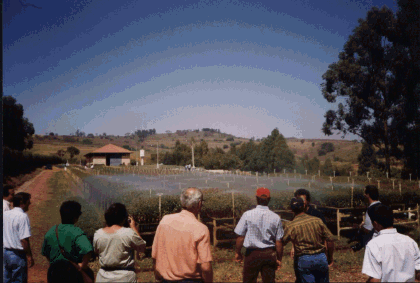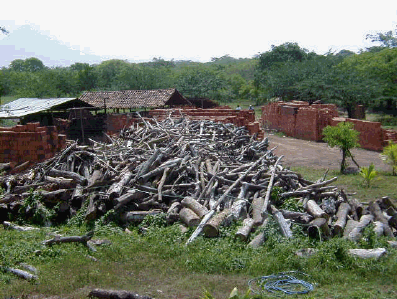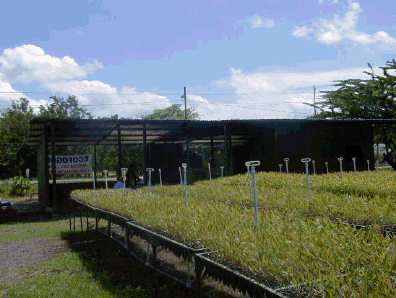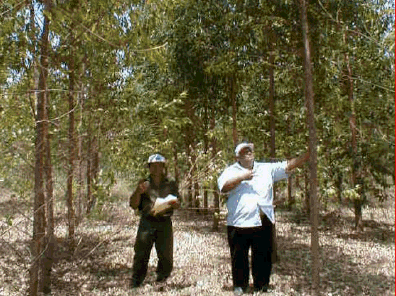0380-C2
From industrial consumers to rural producers: an incentive scheme for reforestation in Brazil and Nicaragua
RogÚrio Carneiro de Miranda, Stuart Conway and Afranio Cesar Migliari *
Abstract
In tropical developing countries there is a trend toward deforestation, since there is a high dependency on tropical forests products, weak forest legislation and law enforcement, and no incentives for reforestation.
An alternative modern forest policy that can address this problem is the formation of Forest Replacement Associations (FRAs) among small industrial consumers of wood and small rural producers. While consumers contribute with capital for tree nursery production, technical assistance and guaranteeing a market, producers on the other hand participate with land and labour, in a joint collaboration for the establishment of industrial reforestation projects surrounding wood-consuming regions.
In Brazil FRAs have been established in many states since 1986. FRAs are an initiative taken by small timber and fuelwood-consuming industries to guarantee a sustainable supply of quality wood for their business, comply with forest legislation and reduce transportation costs.
In Nicaragua, among the leading fuelwood-consuming industries, three FRAs have been established since 2000 as an alternative to stop deforestation and to create an incentive for reforestation for small farmers with private industry capital.
Farmers also benefit since they receive free seedlings for reforestation, complemented by a guaranteed market nearby. In that way, they can diversify their land use, and have a cash crop that can endure difficult conditions in times of natural disasters, while reducing pressure on the surrounding natural forests.
FRAs are a win-win solution for consumers and producers regarding forest production and consumption, however, legislative back up is necessary, together with environmental education of the consuming industries and the local communities.
Introduction
A "Frequently Asked Question" in the developing world is "how to finance reforestation for rural farmers, without international aid? " In the developing world , reforestation is usually a measure needed to counteract deforestation and forest degradation due the country's' need for fiber, timber and energy. The depletion of the natural forests is easier and cheaper than reforestation, and often tropical forests seem inexhaustible.
However, tropical forests are one of the fastest disappearing ecosystems worldwide, since they are usually associated with less developed countries. In these regions, the unspoken policy is "privatize the profits from the country's forests, while socializing the external costs from the degradation of these same forests". Local governments usually lack human and logistical resources to monitor deforestation.
Also, when the proposed solution is reforestation, the long term return on the investment is not attractive for local farmers, and if accepted, the money most likely will be coming from foreign aid.
An alternative solution to this problem is taking place in countries like Brazil and Nicaragua. The creation of regional Forest Replacement Associations among small-scale wood consumers and producers is proving to be an appropriate measure for developing countries, and is independent of foreign aid.
The Methodology
Forest Replacement Associations are a win-win solution for both industrial consumers and rural producers of wood products. It is based on four basic assumptions for the production of any agriculture commodity:
- Land availability
- Labor availability
- Capital availability
- Market availability
Small or medium-scale farmers usually do have land available for reforestation. A small percentage of the land , from 5 to 20%, could be dedicated to a reforestation crop, which could mean anything from ╝ to 10 hectares of land. The same farmers usually have labor available to invest in the project, mostly family labor that will not cost them a cash investment. However, these farmers do not usually invest in reforestation due to the lack of capital or cash to buy at least the seeds or seedlings (the expected cost for the establishment of a hectare for instance may range from US$ 200 to US$ 300, depending on species, soil preparation, fertilization, fences, etc.) , and they also would have to wait usually from 5 to 7 years to harvest for energy (fuelwood) and 12 to 25 years to harvest for timber, and recover the cash investment. Furthermore, farmers usually do not have a guaranteed market for their investment. Either there is no formal contract or contact with buyers, and the market might be quite far, with high transportation costs.
In the other hand, small consuming industries, usually do not have land available for reforestation to sustain their need for wood products and nor the rural labor to plant and care for the plantation. However, as consumers, they are the market, and can guarantee a demand from any supplier. Furthermore, because they are the ones that ultimately define the prices of the final product in which wood is used as raw material or energy, and they also can make a larger profit in the process, consumers do have the control over the profits. Therefore, the consumers should be the ones responsible to financially contribute to the reforestation and replacement of their wood demand, or in other words, to pay for the sustainability of forests for their business.
In the forest replacement system, farmers and consumers of a given region (one or several clustered municipalities) form a partnership to create a Forest Replacement Association (FRA), which should be a legal entity. In Brazil there are models and some state governments and FRA's federation can assist with advice, while in Nicaragua PROLEĐA and the Ministry of Energy can advise as well. Usually, consumers and producers together arrange to set up the tree nursery infrastructure, in which the consumer industry finances the seedling production, as well as the technical assistance to oversee the nursery operation and to assist farmers with training and assistance in reforestation techniques and maintenance.
Each farmer associated or enrolled in the reforestation program has free access to seedlings, and also a guarantee from the industry that they will buy the wood produced, once a fair market price is agreed upon at the time of the harvesting. Farmers have total ownership of their land dedicated to the reforestation and its products, and furthermore have no obligation to sell the wood to the industry, but can either keep it or sell to the highest bidder.
The following table summarizes this scheme by presenting the contribution of resources in a partnership for a forest replacement program:
| Land | Labor | Capital | Market | |
| Small or medium size wood
producing
farmers |
YES
Own and have available between ╝ to 10 hectares of land for commercial/industrial reforestation |
YES
Can contribute at least family labor for reforestation activities |
NO
Do not have available cash, much less for a long term return on the investment |
NO
Does not control or have secure access to it |
| Small or medium size
wood consuming industries |
NO
Does not own agriculture land |
NO
Does not have access to agricultural labor |
YES
Does control profits and is the ultimately responsible for the forest sustainability of their business |
YES
Does control demand and can guarantee contracts |
The Opportunities
In Brazil, since 1975 the forest legislation requires that every industrial or commercial wood consumer should guarantee the sustainability of its wood products needs. If it is a small consumers with demand below 12,000 m3 of wood per year, it should establish its own reforestation project, or it could pay a fee to a forest replacement fund operated by the government as an alternative.
In the State of Sao Paulo, until 1986, the latter option for small consumers was the preferred one, since almost all of their demand came from natural forests without management plans, and there was not enough available forests sustainably managed to satisfy their demand. So, paying a reforestation fee was the easiest solution. However, the forest replacement fund operated by the federal government was ineffective to reforest, and if so, the reforestation projects were usually too far from the geographic areas of the wood needs of the industries. At that time, small industries began to realize that their fee contribution was doing no good to resolve their needs for wood products. Therefore, they created Forest Replacement Associations (See Picture 1), clustered by small or medium size wood consuming industries of the same area or region, in which their contribution fee was invested locally (Toledo e Guimaraes 1993).
In this way, they have a guarantee that their contribution would then create reforestation projects within their region, increasing in the near future a sustainable supply of industrial quality wood, with a much lower transportation cost. An additional benefit of the FRA was that the contribution fee was significantly lower than the one paid to the government due to the efficiency of the FRA administration1.
Picture 1: The infrastructure of Verde Tamba˙, an FRA in the city of Tamba˙ in Sao Paulo state, Brazil.

Farmers of the region also benefited, since they received the minimum incentive2 from the FRA's, increase and diversify their investments on their land, have a guaranteed market nearby, and also have a free choice for the final use of the wood produced. Other benefit for farmers could be the generation of income from the reforested area before the harvest, if for instance strategies like consortium with agriculture and pasture, apiculture, and commercial thinning were to be adopted.
The government in the end also benefits, due to reduced responsibility to create the reforestation programs, with only supervision required, and contributing or facilitating an effective incentive for small farmer/industrial reforestation without public funds, besides effectively supporting an initiative for natural forest protection.
In Nicaragua, based on a feasibility study done by Miranda 2000, a local NGO (PROLEĐA3) took the initiative to establish three FRA's among the three leading fuelwood consuming industries in that country. PROLEĐA also facilitated technical and financial cooperation from the Nicaraguan4 and the Brazilian5 governments, as well from TWP6. In this case, the small rural industries were brick manufacturers, lime manufacturers and fuelwood merchants for the capital city of Managua. (See picture 2)
Picture 2: A typical small family brick industry in La Paz Centro, Nicaragua. In this area about 62 small industries like this one consume about 20,000 tons of fuelwood per year (Miranda 2000).

In this initiative, each cluster of industry provided the land for the establishment of the nursery, the Nicaraguan government provided the infrastructure, while the Brazilian government, PROLEĐA and TWP the expertise for the FRA methodology and the nursery tubete7 technology (including the hardware).
Up to today, each FRA in Nicaragua has the capacity to produce 95,000 trees annually, which will be in full operation by 2003. These FRA's are established in the Pacific region, where the deforestation process has been one the most evident in the country and the demand for rural industry and urban domestic fuelwood is still very substantial in terms of Nicaraguan energy needs.
Small farmers of the region also are expected to have additional security with their investment in reforestation, since the region suffers from time to time from agricultural crop losses from natural disasters such as drought caused by the El Đino meteorological phenomenon and floods such as hurricane Mitch of 1998. When those disasters occur, many small farmers have no other income than cutting and selling their lots of natural forests as fuelwood for the local industries and urban domestic consumers.
In Nicaragua, where there is no incentive for reforestation, and the forestry authorities do not have the resources to enforce sustainable management or control fuelwood consuming industries, FRA's can fill this gap leveraging public resources in favor of private resources to accomplish the sustainable forest management goal.
The Results
Since 1986, when first started in Brazil, FRA's have slowly grown in numbers. Today there are 71 FRA's in twelve states, and in three of them have gone on to format state level federations of FRA.
For instance, in the state of Sao Paulo alone, over 60 million trees have been established with 11,900 small farmers and 35,900 hectares of forest plantations. It is estimated they have a production of 6.3 millions cubic meters of wood available to the small industry, with an added value (including cutting and transport) of at least US$ 63 million to the state rural economy (FARESP 2001).
Besides contribution from local industries, some FRA's in Brazil also receive funds for carbon sequestration from international polluters , from the Ministry of Environment to replant natural forests in watersheds, as penalties from companies who committed environmental crimes, and even from furniture industries to promote timber production closer to their locations. All these resources help these FRA's to maintain financially sound programs.
In Nicaragua, the first FRA started operation in the year 2000, in the municipal nursery of the city of La Paz Centro. At that time, organized and motivated by PROLEĐA, only a handful of enthusiastic brick producers joined the new Probosque FRA. About 60,000 trees of different species were freely distributed among small farmers of that impoverished region. The following year, Probosque grew in number of members to about 12, and with PROLEĐA's assistance , they purchased land along the main highway that crossed their city to establish their tree nursery. The National Energy Commission contributed with the construction of a building, while the Ministry of Forestry, TWP and the Brazilian Cooperating Agency provided the infrastructure for the tree nursery. (See picture 3).
Picture 3: Infrastructure of the FRA Probosque in La Paz Centro in Nicaragua.

By 2001 another 60,000 trees were distributed, while in 2002, 65,000 trees were distributed, and about 25,000 were sold to an NGO from another region. Selling part of their production is a strategy that Probosque adopted in order to raise funds to finance the free distribution to their associated farmers, while the contribution from their few industrial members is still too low to cover the total production costs of the nursery.
Follow up studies of the plantations has shown that even with two years of drought the survival rate of the plantations are about 70%. New farmers are also showing up each year, interested in joining the program (See picture 4).
The majority of the industrial consumers are not yet members of the FRA in Nicaragua, although according to PROLEĐA's survey, the majority of industries agree with the program. However they are taking a very passive attitude, since yet there is no legal obligation to contribute or participate.
Two other FRA's in Nicaragua also have been created: one among fuelwood merchants in the outskirts of the capital city Managua, and another among lime producers of San Rafael del Sur.
Picture 4: Two year old eucalyptus plantation established by Probosque in La Paz Centro, Nicaragua.

Discussion
Although FRA's today are the best alternative to efficiently address sustainability by wood consuming industries, there are still some difficulties. In Brazil for instance, not all states utilize this alternative policy. In Minas Gerais, the state government favored using the contribution fee from forest replacement for conservation instead of reforestation. In other states, weaker law enforcement has led to some unpaid contributions.
Since in Brazil there is a trend for decentralization of forest legislation, in which each state has its own law, the federal forest authorities are pushing the states to include forest replacement and FRA concepts into their state laws. In many states now, public opinion favoring forest replacement and the presence of forest police is helping to enforce forest legislation. Under the new federal government, an initiative to review of current FRA legislation will be carried out in 2003, to propose a new more effective policy to promote and disseminate FRAs in all states of Brazil.
In Nicaragua, FRA is still a modern concept which is being developed in voluntary pilot projects. Although the forestry authorities are gaining interest in this concept, formal inclusion of this principle into the forest law is needed, and it will likely take some time for that to become a reality.
An alternative could be through local municipal laws, where authorities could have a more effective way to regulate the local industry, with controls and incentives. However, municipal government might face initial opposition from the local industries .
A strong environmental education program aimed at the consuming industries, accompanied by the enforcement of the legislation, should be the best approach to really successfully implement a forest replacement policy.
In Nicaragua, where the industries are smaller and in minor numbers than in Brazil for instance, the international cooperating agencies, the government and the NGO's should continue to play a key role in helping to strengthen the FRA concept and its policies, until FRAs are well established.
Conclusion
For developing countries where the small industries rely on wood as timber or energy source, the government has no resources to enforce forest sustainability policies, and there are no public resources to provide reforestation incentives, FRA is a valuable model to address these problems.
First, it will guarantee a continuous supply of wood for those industries who need it to operate; second, it provides a sustainable supply of better quality wood and lower transportation costs with no deforestation consequences; and third, will provide the necessary incentives for small farmers to incorporate forestry into their income generating activities. For farmers it will be a strategically resistant crop to mitigate hard times when agricultural crops are lost, and to alleviate pressure on the remaining natural forest stands.
FRA in the medium term avoids using public and in most cases donor aid funds, in favor of private funds to mitigate an environmental impact created by private industries.
An amount of opposition can be expected, since there is often rejection from private businesses from assuming the social and environmental costs of their profitable operations.
Continuous education of public opinion as well the consuming industries of the key role of FRA for sustainable development will slowly strengthen the FRA concepts in the eyes of forestry authorities, enabling them to implement and enforce FRA as a desirable modern forest policy.
Literature cited
FARESP, 2001. Fatos sobre a reposišao florestal no Brasil. Presentašao as autoridades de Nicaragua. Managua, Nicaragua. 8 pages. Unpublished.
Miranda, R. C. de, 2000. Estrategia de creaciˇn de asociaciones de reposiciˇn forestal en Nicaragua. PRO-ARCA/CAPAS. Managua, Nicaragua. 27 pages.
Toledo, L.R. e Guimaraes O., 1993. Chama Viva: O esforšo das associašoes de reposišao florestal para aumentar a produšao de lenha e poupar as matas nativas. Revista Globo Rural. Rio de Janeiro, Brasil. Ano 8, numero 94: 35-38.
* Representative of PROLEĐA and TWP and Brazil. Rua Amßvel Costa 276, Jaragua, Belo Horizonte, Minas Gerais, 31270-470, Brazil. rmiranda@inet.com.br
1 For instance in Sao Paulo state, for each cubic meter of wood consumed by the industry, they have to replant 8 Ż trees, which they will have to pay only about US$ 0.20 per tree to the FRA to do the work of reforesting, in contrast with US$ 0.50 that they used to pay to the federal government.
2 Minimum incentive here is regarded as free high quality tree seedlings and technical assistance.
3 PROLEĐA is the Association for Wood Energy Development, a pro-development NGO with offices in Nicaragua and Honduras.
4 Though the National Energy Commission (CNE).
5 Trough the Brazilian Cooperating Agency (ABC).
6 TWP: Trees, Water and People, an US based NGO that supports reforestation initiatives in Central and South America.
7 Tubete is a recycled small rigid plastic container used for cultivation of seedlings in the nursery, which is elevated from the soil and irrigated by a mist system. (see pictures 1 and 3 ).